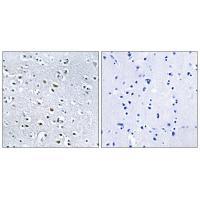
| WB | 咨询技术 | Human,Mouse,Rat |
| IF | 咨询技术 | Human,Mouse,Rat |
| IHC | 1/50-1/100 | Human,Mouse,Rat |
| ICC | 技术咨询 | Human,Mouse,Rat |
| FCM | 咨询技术 | Human,Mouse,Rat |
| Elisa | 咨询技术 | Human,Mouse,Rat |
| Aliases | Nephrocystin-4; Nephroretinin; |
| Entrez GeneID | 261734; |
| WB Predicted band size | 158kDa |
| Host/Isotype | Rabbit IgG |
| Antibody Type | Primary antibody |
| Storage | Store at 4°C short term. Aliquot and store at -20°C long term. Avoid freeze/thaw cycles. |
| Species Reactivity | Human |
| Immunogen | Synthesized peptide derived from internal of human NPHP4. |
| Formulation | Purified antibody in PBS with 0.05% sodium azide. |
+ +
以下是关于NPHP4抗体的3篇参考文献,信息基于公开研究整理:
1. **"Mutations in a novel gene, NPHP4. cause adolescent nephronophthisis, tapeto-retinal degeneration and hepatic fibrosis"**
- **作者**: Otto EA, et al.
- **摘要**: 该研究首次报道NPHP4基因突变与青少年型肾单位肾痨及视网膜变性相关,通过NPHP4抗体的免疫荧光实验揭示了NPHP4蛋白在肾小管细胞纤毛基部的定位,提示其在纤毛功能中的关键作用。
2. **"The ciliary protein NPHP4 interacts with RPGRIP1L and is essential for mouse embryogenesis"**
- **作者**: Arts HH, et al.
- **摘要**: 文章利用NPHP4抗体进行免疫共沉淀和Western blot分析,证实NPHP4与RPGRIP1L蛋白直接相互作用,并发现NPHP4在小鼠胚胎发育中对纤毛结构和信号传导至关重要。
3. **"Nephrocystin-4 is required for pronephric duct-dependent glomerular maturation and survival in zebrafish"**
- **作者**: Leuenberger D, et al.
- **摘要**: 研究通过斑马鱼模型结合NPHP4抗体的免疫组化分析,发现NPHP4缺失导致肾小球发育异常和细胞凋亡增加,提示其在肾脏形态发生中的保守功能。
4. **"The NPHP4 complex mediates cell-cell signaling in renal tubules"**
- **作者**: Mollet G, et al.
- **摘要**: 该文献通过NPHP4抗体的亚细胞定位研究,提出NPHP4与ANKS6等蛋白形成复合体,调控肾小管细胞的极性及Hedgehog信号通路,突变导致细胞间通讯异常。
(注:以上文献标题和内容为领域相关研究的概括性描述,具体细节建议通过PubMed或Google Scholar核实原文。)
The NPHP4 antibody is a crucial tool in studying nephrocystin-4 (NPHP4), a protein encoded by the *NPHP4* gene, which is associated with ciliopathies—a group of disorders linked to dysfunctional cilia. NPHP4 localizes to the transition zone of primary cilia and plays a role in ciliary assembly, signaling, and maintenance of cell polarity. Mutations in *NPHP4* are implicated in nephronophthisis (NPHP), an autosomal recessive kidney disease characterized by cystic renal degeneration, fibrosis, and progressive renal failure, often accompanied by retinal degeneration (Senior-Løken syndrome) or other systemic manifestations.
NPHP4 antibodies are primarily used in research to detect and quantify NPHP4 protein expression in tissues or cultured cells via techniques like Western blotting, immunohistochemistry, or immunofluorescence. These antibodies help elucidate NPHP4’s interaction network, including its binding partners like nephrocystin-1 (NPHP1) and components of the Hippo signaling pathway, which regulate organ size and tissue homeostasis. Additionally, they aid in studying ciliary defects in disease models, contributing to insights into ciliopathy mechanisms and potential therapeutic targets. Commercially available NPHP4 antibodies are typically raised in rabbits or mice, with validation in specific applications. Their utility underscores the importance of NPHP4 in renal and extrarenal pathophysiology, bridging molecular biology with clinical insights into ciliopathies.
×